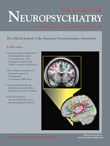Pisa Syndrome Resolved After Switching to Olanzapine
SIR: Pisa syndrome, or pleurothotonus, is a rare dystonic reaction commonly associated with prolonged antipsychotic medication. The treatment of Pisa syndrome at present is empirical, reflecting a poor understanding of its underlying pathophysiology. 1 The first-line treatment for Pisa syndrome remains a reduction in dose or discontinuation of antipsychotics, and the second-line treatment is an anticholinergic medication. 1 Here, we present a case of Pisa syndrome that developed during treatment with risperidone. Although both therapies were ineffective, the problem was resolved successfully after the medication was switched to olanzapine.
Case Report
“Mr. A,” a 29-year-old man with a 3-year history of DSM-IV schizophrenia, had no history of head trauma or other neurological problems, and had no family history of dystonia or other movement disorders. In October 1999, he was admitted to the psychiatric unit for 9 months because of a severe psychotic exacerbation resulting in self-injuries of the tongue with scissors. A regimen of bromperidol, a maximum of 27 mg/day, and biperiden, 3 mg/day, was implemented with consequently good results. In the outpatient clinic, bromperidol was switched to risperidone at 4 mg/day, and then biperiden was discontinued.
In January 2001, 4 months after the initiation of risperidone, Mr. A was observed walking with a tilt toward the left. Physical examination showed tonic flexion of the trunk toward the left along with a slight backward axial rotation, classically referred to as Pisa syndrome. No evidence of other extrapyramidal symptoms was found. Secondary dystonias resulting from metabolic disorder, organic disorder, or infection were ruled out. The regimen of trihexyphenidyl was attempted for 4 weeks but no benefit was seen. A regimen of risperidone, 4 mg/day, was then reduced, step by step and cautiously, to 1 mg/day in 2 months. No improvement in Pisa syndrome was observed after 2-month observation with this dose. Because of the risk of psychotic relapse, risperidone, 1 mg/day, was successively switched to olanzapine, 5 mg/day, despite its discontinuation in August of 2001. Pisa syndrome gradually improved, and the symptoms disappeared within 2 months. Two years after olanzapine treatment, the patient was found to be in remission from the psychosis with no signs of Pisa syndrome.
Comment
The substitution to atypical antipsychotics, particularly clozapine, may provide alternatives for the treatment of patients with tardive dystonia. 2 Olanzapine, which has pharmacological similarities to clozapine, has been also suggested to be effective in the treatment of tardive dystonia. 3 For the treatment of Pisa syndrome, the usefulness of atypical antipsychotics has been mentioned only in a few case reports on clozapine 4 and amisulpride. 5 In this case, it remains unclear whether the clinical resolution of Pisa syndrome represents an antidystonic effect of olanzapine or simply a spontaneous remission of Pisa syndrome after the withdrawal of the offending drug, risperidone. Similar claims have been made for clozapine in the treatment of tardive dystonia. 4
Although the pathophysiological mechanism is still unclear, this case report demonstrates a possible usefulness of olanzapine as an antipsychotic mono-therapeutic strategy for Pisa syndrome, even if the syndrome is triggered by other atypical antipsychotics such as risperidone.
1. Suzuki T, Matsuzaka H: Drug-induced Pisa syndrome (pleurothotonus): epidemiology and management. CNS Drugs 2002; 16:165–174Google Scholar
2. Tarsy D, Baldessarini RJ, Tarazi FI: Effects of newer antipsychotics on extrapyramidal function. CNS Drugs 2002; 16:23–45Google Scholar
3. Lucetti C, Bellini G, Nuti A, et al: Treatment of patients with tardive dystonia with olanzapine. Clin Neuropharmacol 2002; 25:71–74Google Scholar
4. Diez-Martin JM: The Pisa syndrome as another acute dystonia subtype. J Drug Dev Clin Pract 1995; 7:59–61Google Scholar
5. Ziegenbein M, Schomerus G, Kropp S: Ziprasidone-induced Pisa syndrome after clozapine treatment. J Neuropsychiatry Clin Neurosci 2003; 15:458–459Google Scholar



